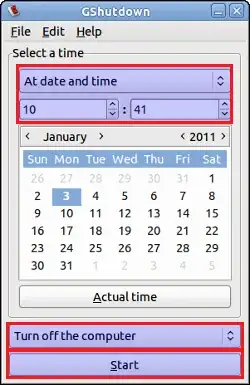How can I automatically shutdown the system after a certain customizable time?
7 Answers
Open a terminal window and type in:
sudo shutdown -h +60
and just replace 60 with whatever number of minutes you want to take.
More info here:
http://ubuntuforums.org/archive/index.php/t-473173.html http://www.linux.org/lessons/beginner/l5/lesson5a.html
Because the topic abt shutting down PC after certain period of inactivity is redirected to this topic, I will explain this issue here.
I spent lots of time to solve this problem, so I find it useful to share it, to make the same issue simple for others. I hv tried different programmes but they haven't work for me so I found using short script with cronjob the best solution.
Firstly I refered to post Timed Shutdown - shutdown after 30 minutes
I will copy it below and then explain improvements to make it work:
Install xprintidle. This tool gives the idle time of a user.
sudo apt-get install xprintidleMake a script autoshutdown.sh which checks for the idle time and instructs the computer to shutdown if idle for 30 minutes.
idle=$(xprintidle) if [ $idle -gt 1800000 ]; then shutdown -h now fiMake a cronjob for this that checks from time to time if the system has been idle for too long and if it has been idle for a longer than 30 minutes it will shutdown. Note that the cronjob has to be made for the root user.
This script needs some improvements to work, like:
idle=`env DISPLAY=:0 su OUR_USER -c xprintidle 2>&1`
OUR_USER is the user we refer to for checking idle time (not root user)
DISPLAY=:0 is correct for one desktop display (run env command to read DISPLAY in your situation)
if script is run by OUR_USER, line above can be reduced:
idle=`env DISPLAY=:0 xprintidle 2>&1`
This topic is described http://ubuntuforums.org/showthread.php?t=1069602
if script is run by OUR_USER, shutdown command should be preceded by sudo
sudo shutdown -h now
My script was run from cron by line in cron file:
*/5 * * * * /home/OUR_USER/autoshutdown.sh
- every 5 minutes
- OUR_USER should be replaced as earlier to the user we refer to.
If script is not run by root we should remember to add the line:
ALL ALL=(ALL) NOPASSWD: /sbin/shutdown
in sudoers file, so shutdown command won't need a password to be executed.
I tried such cronjobs on 2 similar distro Lubuntu 12.04.4 RC LXLE 32-bit ( http://www.lxle.net/ )
In one system it works only using root cronjob set in file:
/var/spool/cron/crontabs/root
CAVEAT
Another problem is that xprintidle in my system has given sometimes random for me values and sometimes logically incremental. The final result - my system has been usually shutdown after 20 mins maybe, if I set the max idle value to 30 mins. I think the culprit is xscreensaver which doesn't work as is set by entered parameters.
You can use sleep for that. They're used to delay/ pause an operation. Combine that with shutdown you get a power off timer.
Example to sleep after 1 hour:
sleep 3600 && sudo shutdown now
You can use math as well, here's to power off after 3 hour:
sleep $((3600*3)) && sudo shutdown now
- 11
You can use
ComplexShutdown https://launchpad.net/complexshutdown
or EasyShutdown https://launchpad.net/easyshutdown
- 33
Crontab seemed like the perfect and most convenient solution for a scheduled shutdown.
But I could not get it running for quite a while using (as supplied by Chat):
crontab -e
30 22 * * * /sbin/shutdown -h now
My solution was to create a crontab, but as superuser. Makes sense, dont want any old bod shutting down the server.
sudo crontab -e -u root
Then add PW,select text editor
Then:
30 22 * * * /sbin/shutdown -h now
Works for me.
Another option is Shutdown Timer, a GNOME Shell extension.
An old version for older GNOME version is still available.
To be able to use GNOME Extension, type into a terminal:
sudo apt install chrome-gnome-shell gnome-shell-extension-prefs
- 13,891

